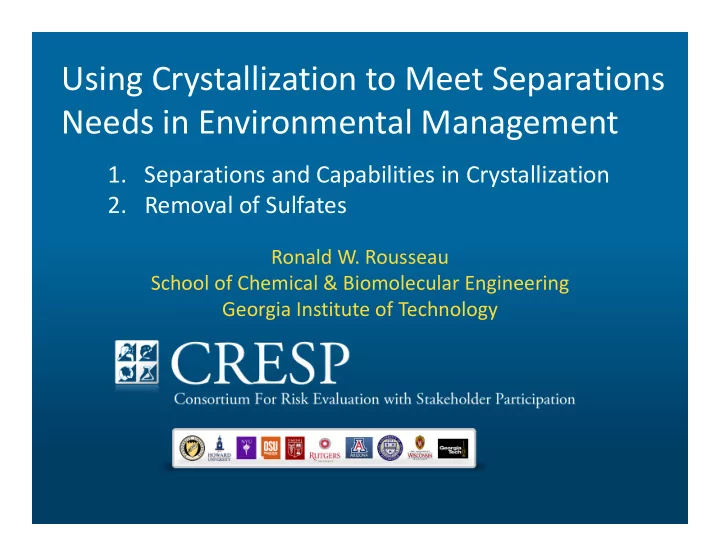

Using Crystallization to Meet Separations Needs in Environmental Management 1. Separations and Capabilities in Crystallization 2. Removal of Sulfates Ronald W. Rousseau School of Chemical & Biomolecular Engineering Georgia Institute of Technology
Separation Technologies in EM: Role of Crystallization • Crystallization of pure mineral phases from supersaturated solutions 1 • Pretreatment processes 2,4 • Selective separations using new molecules and materials 3,5 • Sulfate removal 4,5 1. Nuclear Separations Technologies Workshop Report, DOE, July 2011, p. B ‐ 23 2. Ibid, p. C ‐ 7; 3. Ibid, p. B ‐ 4; 4. L. Nassif, G. Dumont, H. Alysouri, R. W. Rousseau, D. Geneisse, Environ. Sci. Technol. , 2008, 42, 4940. 2 5. A. Rajbanshi, B. A. Moyer, and R. Custelcean, Cryst. Growth Des. , 2011, 11, 2702.
Crystallization Research Team ChBE, Georgia Tech • Daniel Griffin, Graduate Research Assistant • Martha Grover, Associate Professor • Yoshiaki Kawajiri, Assistant Professor • Huayu Li, Graduate Research Assistant • Ronald W. Rousseau, Professor Expect interactions with other research teams: • Bruce Moyer at ORNL • Bill Wilmarth and David Hobbs at SRNL 3
Crosscutting Criteria/Needs for Successful Crystallization Processes • Yield: recovery of solute in process • Purity: contamination of product • Crystal Characteristics: size distribution and morphology Crystal Characteristics Crystallization & Solid ‐ Liquid On ‐ Line Measurements Yield Purity Sep’n 4
GT Work on Size Distribution • FBRM provides – chord counts in histogram format – mean of chord lengths distribution – skewness of histogram • Cord counts Crystal Sizes – geometric model* – optical model** – empirical model (this work) * J. Worlitschek, T. Hocker, M. Mazzotti , Part. Part. Syst Charact. , 2005. 22, 81. ** N. Kail, , H. Briesen, W. Marquardt, Powd. Techn, 2008. 185, 211. 5
Experimental Results • Fingerprint vector for every size. 0.05 20~53 m 53~75 m 75~106 m 0.04 106~150 m 150~212 m 212~250 m 0.03 250~300 m u [ml] 300~425 m 425~500 m 0.02 0.01 0 0 50 100 150 200 250 300 Chord length [ m] • The linearity and additivity is validated by mono size distribution and mixing of different sizes. 1 b Ux x U b 6
Sulfates Cause Issues In Vitrification and Other Storage Forms • Poor glass characteristics • Corrosion • Potential process instabilities 7
Integration of Sulfate Removal Sulfate ‐ containing streams Sludge Al dissolution and processing Sulfate Vitrification Removal Salt/Supernatant Appropriate Processing Sulfates Salt processing • Separate sulfates in forms that do not need to be vitrified – very low levels of radioactive species – perhaps eligible for saltstone disposal • Use of crystallization – crystallize sulfate without Cs and contaminants; i.e. eliminate co ‐ crystallization, inclusions – facilitate washing and solid ‐ liquid separation 8
Experimental Plan • Framework for separation • Use developed tools: – FBRM (CSD) – FTIR (solution composition) • Sulfate solubility in complex solutions • Develop process format 9
Concluding Comments • Separations technologies are essential for remediation of environmental issues • Crystallization is a promising method for many separations issues • We have advanced crosscutting capabilities for on ‐ line monitoring of crystal size distribution • We have begun working on the removal of sulfates from complex solutions 10
Recommend
More recommend